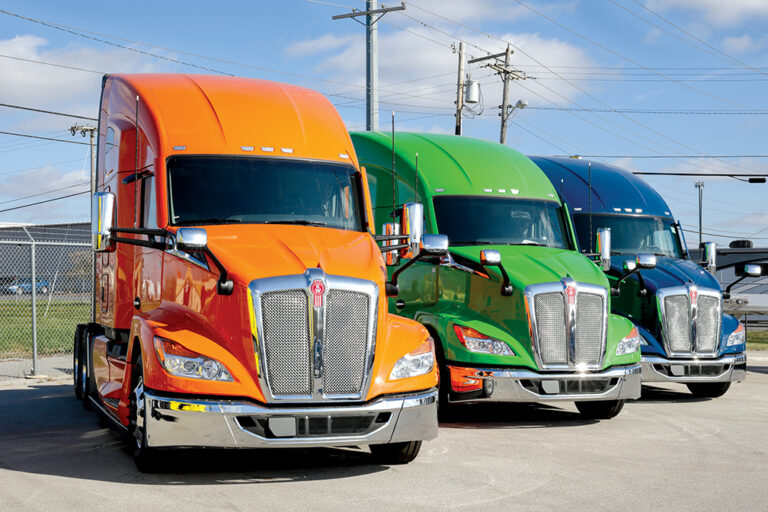For months, analysts have predicted a slowdown in sales of Class 8 trucks. It appears that it’s finally happening — although at a slower rate than some anticipated. U.S. sales of new, Class 8 trucks declined to 21,417 in October, according to data received from Wards Intelligence. That number is 3.7% lower than September sales and 6.3% lower than sales reported in October 2022.
This is important, because freight rates aren’t likely to rise significantly until the number of available trucks is reduced — and that can’t happen as long as new truck sales remain strong.
The new Class 8 truck market started slowly in 2022, with sales in the first four months lagging behind their corresponding month a year earlier. In April 2022, however, sales were only 1.3% behind April 2021 sales. In May 2022, they were 13.9% higher than May 2021. In June it was 12.7% — and then July saw sales 21.9% higher than July 2021.
After that, trucks were selling like gangbusters.
Sales of new Class 8 trucks jumped 29.7% in August 2022, 34.1% in September and 34.5% in October; then November saw sales that were 39.5% higher than November 2021. December sales were “only” 18.2% higher than the previous December, but January 2023 figures came in 33.3% higher than January 2022. February of this year reached 35% higher … and then the downward trend began.
Until July 2023, sales were better than the corresponding month in 2022, but the margin got smaller each month. Finally, in August, sales were 1% lower than August 2022. They crept to 3.2% lower in September, then down 6.3% lower in October. The graph is clearly pointing downward.
One statistic that provides insight about where the market is headed is the number of truck orders. Final numbers for October haven’t been released at the time of this writing, but several firms list preliminary numbers.
FTR Intel reported preliminary North American orders of 28,000 units, down 10% from September and down 35% from October 2022. The report notes that demand for new trucks was “exceptional” in 2022. Current numbers could be considered more normal than as a low point.
“The overall picture for truck demand is steady,” said Eric Starks, chairman of the board for FTR. “Despite freight weakness, fleets continue to be willing to order new equipment, affirming our expectations of replacement demand during 2024.”
ACT Research issued its preliminary North American order report showing orders of 31,900 in October.
ACT President and Senior Analyst Kenny Vieth explained, “Even though backlogs, in seasonal fashion, are rising, they continue to point to a different market vibe heading into 2024,” said Kenny Vieth, president and senior analyst at ACT Research. “As we head into 2024, the absence of the large backlog cushion the industry has enjoyed the past two years underscores the importance of seasonal order activity in the coming months.”
Veith is referencing the nearly one-year order backlog that builders faced last year. Even though delivery of new trucks could take a year, buyers continued ordering. Some orders were to replace aging equipment, but some were ordered to be ready when freight rates rebounded — an event that didn’t happen.
ACT’s number is different than FTR’s because both numbers are an estimation based on the data each firm has received, and that data may not be identical. Further, different formulas could be used to calculate projections. Finally, some differences occur in which manufacturers are included in the totals. Smaller manufacturers of vocational trucks are often left out of analyst projections.
On the used truck front, the number of Class 8 trucks on the market rose by 10% over September numbers and by 27% over October 2022, according to ACT Research.
Even better news for buyers is that the price of the average used truck on the market is 25% lower than it was a year ago — and those trucks are younger and have fewer miles on them. Higher interest rates undoubtedly consume some of the cost savings, but used trucks are becoming easier to find.
Unfortunately, freight to haul with those trucks is not easier to find.
Getting back to new truck sales in the U.S. for October, along with individual OEM performance, Freightliner sales of 6,651 were down 15.5% from September sales and down 26.6% from October 2022. Both reflect the largest declines by percentage of any manufacturer. October 2023 was the worst month for Freightliner since February of 2022.
At the same time, both Kenworth and Peterbilt saw excellent Octobers. Kenworth sales of 3,682 topped September sales by 22.8% and were 21.6% ahead of October 2022 sales. Peterbilt’s 3,612 were 4.5% higher than September sales and 6.7% ahead of October 2022.
Added together, PACCAR sales of 7,294 topped Freightliner sales by 9.7%, a feat that does not happen often. In fairness, however, Western Star is owned by Freightliner so their sales of 945 should be counted, giving the Freightliner companies an edge of 7,596 over 7,294, or 302 trucks for the month.
International truck sales fell below 3,000 for the first time since February. Sales of 2,833 were 11.5% lower than September’s 3,202 and 6.9% lower than October 2022, when 3,024 trucks were sold.
Volvo reported U.S. sales of 2,212 Class 8 trucks, down 7.6% from September’s 2,606 and down 15.1% from October 2022 sales of 3,042.
Mack sales of 1,469 in October were down 9.4% from September sales of 1,622 but were 10.6% better than sales of 1,328 last October.
Tesla reported no sales for October, the third consecutive month of zero trucks moved for the manufacturer after reporting sales of 197 in the first seven months of the year. Medium-duty truck maker Hino reported sales of 13 Class 8 trucks in October, their first of the year.
For the year to date, Freightliner sold 37.2% of the Class 8 trucks on the U.S. market, down 1.1% from last year. International’s 14.2% share is 1.7% larger than last year’s. Kenworth holds 14.3%, while Peterbilt holds 14.6%. Volvo is at 9.9%, and Mack is at 6.7%, with Western Star holding 3% of the market.
The mysterious “other” category, which includes both Tesla and Hino, has finally sold enough trucks to register at 0.1% of the new truck market.
Expect November new Class 8 sales to drop precipitously from an unusually strong November 2022 as the market retraction continues.
Cliff Abbott is an experienced commercial vehicle driver and owner-operator who still holds a CDL in his home state of Alabama. In nearly 40 years in trucking, he’s been an instructor and trainer and has managed safety and recruiting operations for several carriers. Having never lost his love of the road, Cliff has written a book and hundreds of songs and has been writing for The Trucker for more than a decade.














